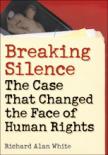Murdered in Paraguay
Imagine this: Your teenage son has been tortured to death under the regime of a Latin American military dictator. Imagine too, that instead of quietly succumbing to your grief, you publicly denounce the murder and speak out against the regime—that of the Paraguayan dictator, Alfredo Stroessner. This is what happened in the landmark Filártiga case, as described in Richard Alan White’s important book, Breaking Silence: The Case That Changed the Face of Human Rights.
Here is the background of the case. In March of 1976, the 17-year-old son of Joel Filártiga, M.D., one of General Stroessner’s most outspoken critics, was tortured on the orders of police inspector Américo Peña, who lived near the Filártigas. The torture was so severe that the youth died. Attempting to cover up the crime, Inspector Peña claimed that Joelito was killed by the jealous husband of a young woman friend. Within hours of the murder, he forced Joelito’s 20-year-old sister, Dolly, to come to the house and, with the help of a neighbor, remove the mutilated body. Once Dr. Filártiga returned home and saw it, he recognized at once the marks of deliberate torture. He himself had been tortured a decade earlier for providing medical assistance to a resistance group. In a bold move, he took photographs of the body and distributed them widely as he began his efforts to seek justice.
The book’s author, Richard Alan White, long-time senior fellow at the Council on Hemispheric Affairs in Washington, D.C., had met the Filártiga family in the early 1970’s while pursuing postdoctoral studies in Paraguay. An admirer of Dr. Filártiga—both for his acclaimed art and for his medical work among impoverished farmers at a rural clinic he and his wife founded and ran—White became virtually a member of the family. After the murder, that relationship deepened as he became a key player in the family’s efforts to publicize the crime among those who might be able to assist in the quest for justice. Through his connections at the University of California, Los Angeles—his academic base at the time—he was able to arrange for exhibits of Dr. Filártiga’s art there and elsewhere. Dr. Filártiga was often present and spoke out about the politically motivated murder of his son in the context of the human rights violations common under the Stroessner regime. As interest grew, they engaged the support of Amnesty International, which published and distributed a pamphlet on the case—the first time it had taken such a step for a single case.
White himself was not immune from danger: his work on behalf of the Filártigas was well known to the Stroessner regime. In an article on the case for America (4/23/77) entitled “Political Murder in Paraguay,” for instance, he felt obliged to write under a pseudonym, Alberto Cabral. White’s status as an American citizen, together with his connections to the U.S. embassy in Paraguay, gave him some measure of protection from retaliation by the secret police. It is this close personal involvement in the case, together with his deep friendship with the family, that gives the book much of its “I-was-there” tone as he describes the unfolding of events that eventually led to a remarkable victory. The family itself, however, had little protection from the ire of the Stroessner regime. Death threats abounded, along with other forms of harassment. On one occasion, vandals broke into the clinic and destroyed much of the medical equipment.
The stress on all members of the family was profound. Dolly, the first to see her brother’s mutilated corpse, subsequently suffered a breakdown. Eventually, she fled to the United States and sought political asylum. As international pressure grew, Peña also fled to New York on a tourist visa. But he had no plans to return, and simply took up residence in Brooklyn, his intended safe haven. In a remarkable turn of events, Paraguayan acquaintances of a horrified Dolly told her of seeing him. With the help of White and dedicated human rights lawyers, she initiated a legal process that eventually led to Peña’s being sued in civil court.
The process was based on an old and seldom used federal statute, the 1789 Alien Tort Claims Act. Ms. Filártiga and the attorneys working with her succeeded in updating the statute in such a way that it could be used on behalf of victims of torture and murder and their survivors. Thus, three years after Joelito’s death, a federal appeals court found Peña liable for the murder. The ruling established an important legal precedent. Since then, in almost 20 cases, torture survivors or their relatives have been able to gain some measure of justice in civil courts here. Though none of the $10-million-damages award has ever been collected, and although Peña was able to return to Paraguay relatively unscathed, the precedent set by the Filártiga case has made it more difficult for abusers of human rights to find shelter in the United States.
The most recent and notable example of the use of the Alien Tort Claims Act concerns the murder of Archbishop Oscar Romero in 1980. In September of this year, a federal judge in California found a former Salvadoran air force officer liable in that murder. The act’s effectiveness—present and future—was underscored when the U.S. Supreme Court issued a ruling on June 29, 2004, that upheld the act’s validity. The ruling was handed down despite intense opposition by the Bush administration.
Torture continues to take place in nations around the world, but Breaking Silence provides a vivid example of a case pursued in U.S. courts that brought to one victimized family a sense of vindication. It has also served as a basis of hope for the families of others, whose victimizers have sought refuge among us.
This article also appeared in print, under the headline “Murdered in Paraguay,” in the October 11, 2004, issue.








